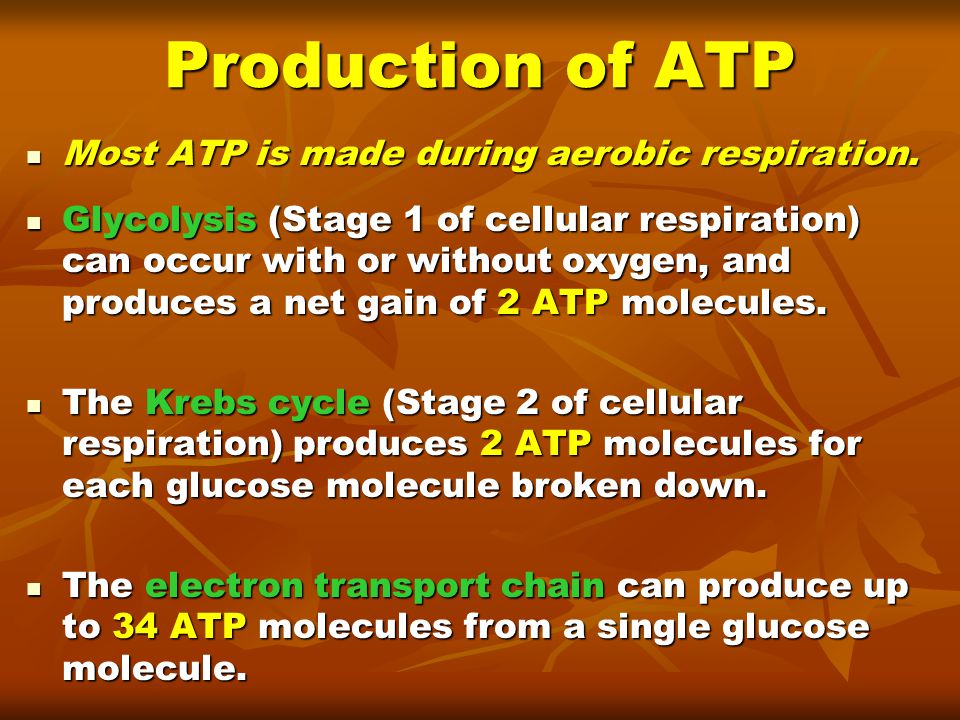Which Step in Aerobic Cellular Respiration Produces the Most Atp
11 What do aerobic and anaerobic respiration have in common apex. Although necessary for multicellular life in an ironic twist of fate aerobic cellular respiration is thought to also be responsible for the processes that end multicellular life.

Energy Cellular Respiration Mitochondria What Is Produced From Eating Food Heterotrophs Or Made By Plants Autotrophs That Is Necessary For Cellular Ppt Download
The Krebs cycle takes place inside the mitochondria.

. Aerobic respiration goes through glycolysis the citric acid Krebs cycle and oxidative phosphorylation the electron transport chain. The Krebs cycle produces the CO2 that you breath out. Likewise which pathway generates the most ATP quizlet.
Which stage of glucose metabolism produces the most ATP. Anaerobic respiration goes through glycolysis and fermentation. This stage produces most of the energy 34 ATP molecules compared to only 2 ATP for glycolysis and 2.
Glycolysis is the process that cells use to break down glucose in order to produce ATP. How many ATP are produced in aerobic respiration. At which step is most CO2 produced.
Citric Acid Cycle Glycolysis Oxidative Phosphorylation Pyruvate Oxidation 2Which step of aerobic cellular respiration yields the most NADH. The stage that produces most of the ATP during cellular respiration is the electron transport system ETS present in mitochondria. What Stage Of Cellular Respiration Yields The Most Atp.
In three stages cellular respiration takes place. The Krebs cycle produces the CO 2 that you breath out. This stage produces most of the energy 34 ATP molecules compared to only 2 ATP for glycolysis and 2 ATP for Krebs cycle.
The first stage glycolysis is the splitting of the glucose molecule and the reactions take place in the cytoplasm of cells. Which step in aerobic respiration produces the most ATP. O 2 acts as the terminal electron acceptor in the electron transport chain and gets reduced to water.
Cellular respiration that proceeds in the presence of oxygen is aerobic respiration. Aerobic respiration produces more ATP than anaerobic respiration due to the complete oxidation of glucose to CO 2 and water. Oxidative phosphorylation marks the terminal point of the cellular respiration and the main sequence that accounts for the high ATP yield of aerobic cellular respiration.
Aerobic respiration process is the most common cellular respiration process that occurs in all multicellular living organisms such as bacteria fungi plants animals etc. Electron transport begins with several molecules of NADH and FADH 2 from the Krebs cycle and transfers their energy into as many as 34 more ATP molecules. Aerobic cellular respiration has three stages glycolysis the citric acid cycle and the electron transport chain.
Cellular Respiration review Answers Aerobic cellular respiration is. View Cellular Respiration review answerspdf from BIOL MISC at Vancouver Community College. Mitochondrial electrons transport one argons exist in 34 of 38 total ATPs are produced by the electron transport system present in the mitochondria.
Most of the ATPs are produced by oxidative phosphorylation in the electron transport chain. Glycolysis takes place in the cytoplasm whereas the Krebs cycle and the electron transport chain which generate the largest amounts of ATP. Generates the most ATP formed by cellular respiration.
9 How is aerobic respiration best compared or contrasted to fermentation. What molecule is the final electron acceptor at the end of the ETC. Which step in aerobic cellular respiration produces the most ATP.
Glycolysis is the division of glucose into two pyruvate molecules where 2 NADH and 2 ATP molecules are formed which in total is 8 ATP molecules as 1 NADH 3 ATP while in mitochondria where 10 NADH molecules 2 FADH and 4 ATP molecules are formed 38 ATP. 10 What are the similarities and differences between cellular respiration and fermentation. Begins with the breakdown of glucose.
8 What are the 5 differences between aerobic and anaerobic respiration. Citric Acid Cycle Glycolysis Oxidative Phosphorylation Pyruvate Oxidation 3. Glycolysis produces two ATP molecules and the Krebs cycle produces two more.
12 How are aerobic and muscular fitness. Discuss the process of Glycoysis Krebs cycle and The Electron Transport Chain Outline each step in detail. The formation of ATP occurs by oxidative phosphorylation.
The Krebs cycle takes place inside the mitochondria. The component of aerobic respiration that produces the most ATP per mole of glucose is. Furthermore which of the three stages of cellular respiration produces the most ATP.
Electrons are transferred from NADH or FADH 2 to O 2 by a series of carriers and are coupled. The electrons move in the cell via oxidatively stimulated phodyric phosphorylation thereby producing most of the ATP. In this process in the presence of Oxygen molecule the sugar content burns and produces energy for the cell.
Theoretically 34 ATPs are produced in the ETS by the complete oxidation of a glucose molecule. Which step of aerobic cellular respiration yields the most ATP. Aerobic respiration is a type of cellular respiration that uses oxygen to help convert the energy in glucose into a usable form.
Aerobic respiration occurs with greater efficiency producing 36-38 ATP while anaerobic. Most of the ATP in cellular respiration is produced by the process of chemiosmosis. Electron Transport Chain At the end of the electron transport chain what atom is the final electron acceptor.
Cellular respiration comes in two forms.

Cellular Respiration Ck 12 Foundation

Solved Which Stage Of Aerobic Respiration Produces The Most Chegg Com

Comments
Post a Comment